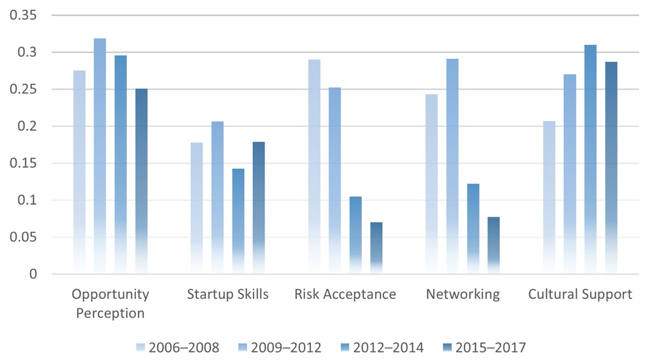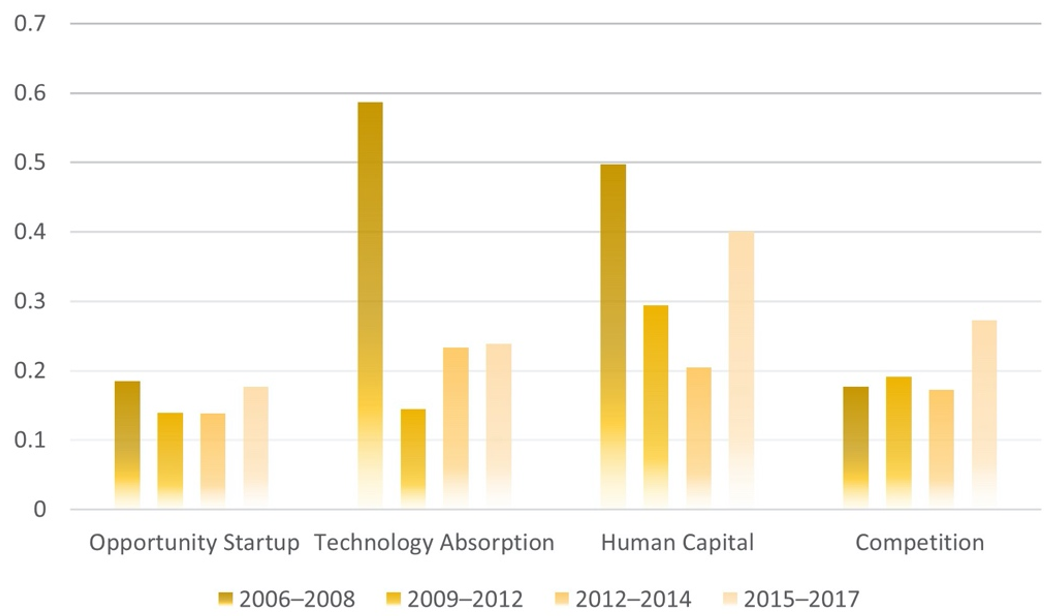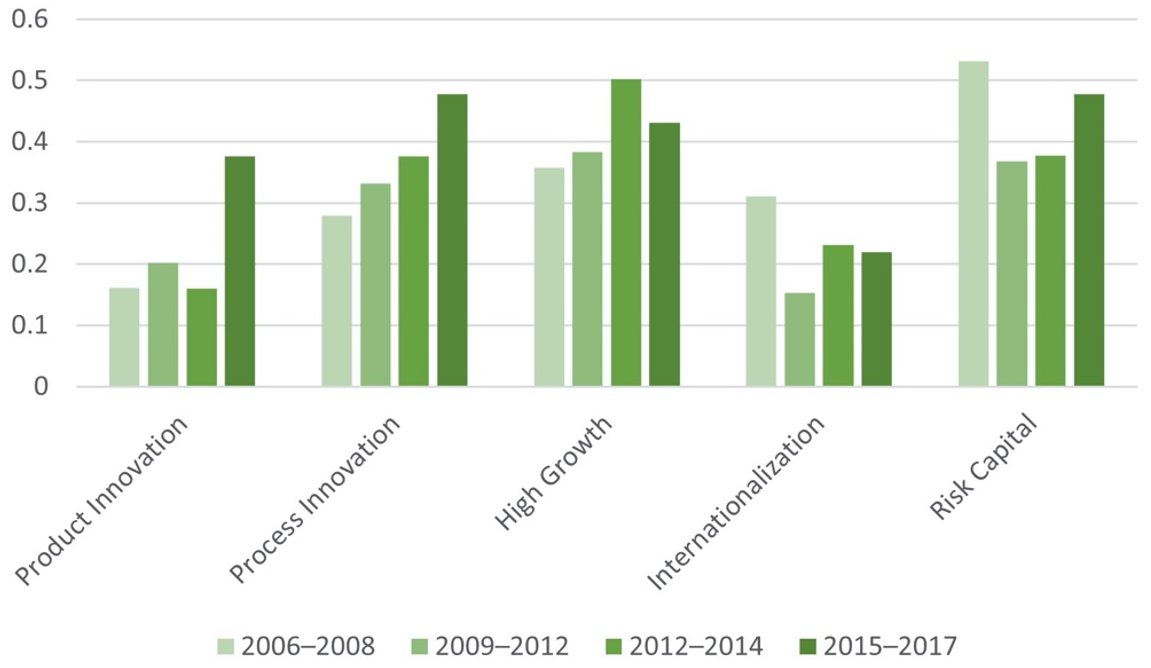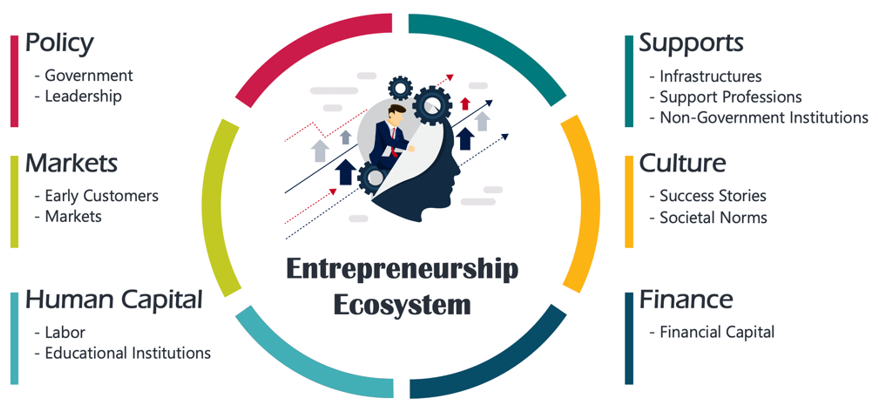Entrepreneurship Ecosystem Performance in Egypt: An Empirical Study Based on the Global Entrepreneurship Index (GEI)
Abstract
1. Introduction
2. Literature Review: Entrepreneurship Ecosystem
3. Methodology, Materials, and Methods
3.1. Entrepreneurship Development Performance in Egypt
3.2. The Global Entrepreneurship Index (GEI)—Motivations and Considerations
3.3. Data Collection
4. Results and Discussion
4.1. Egyptian Entrepreneurial Performance Based on the GEI: Trends of Sub-Indexes and Pillars
4.2. The Analysis of Egyptian Entrepreneurial Profile
4.3. The Analysis of Entrepreneurial Profiles-Institutional vs. Individual Variables
4.4. Comparison Analysis for Egyptian Context
4.5. Penalizing for Bottleneck Method Analysis (PBM)
5. Conclusions and Policy Suggestions
6. Limitations and Future Research
Author Contributions
Funding
Institutional Review Board Statement
Informed Consent Statement
Data Availability Statement
Acknowledgments
Conflicts of Interest
Abbreviations
Appendix A
| GEI’s Pillars | Descriptions and Definitions |
|---|---|
| Opportunity Perception | This pillar captures the potential “opportunity perception” of a population by considering the state of property rights and the regulatory burden that could limit the real exploitation of the recognized entrepreneurial opportunity. |
| Startup Skills | Launching a successful venture requires the potential entrepreneur to have the necessary startup skills. Skill Perception measures the percentage of the population who believe they have adequate startup skills. Most people in developing countries think they have the skills needed to start a business, but their skills were usually acquired through workplace trial and error in relatively simple business activities. |
| Risk Acceptance | Of the personal entrepreneurial traits, fear of failure is one of the most important obstacles to a startup. Aversion to high-risk enterprises can retard nascent entrepreneurship. Risk Perception is defined as the percentage of the population who do not believe that fear of failure would prevent them from starting a business. Country Risk reflects to transfer and convertibility risk of a country and believed to closely correlate to business. |
| Networking | Networking combines an entrepreneur’s personal knowledge with their ability to connect to others in a country and the whole world. This combination serves as a proxy for networking, which is also an important ingredient of successful venture creation and entrepreneurship. |
| Cultural Support | This pillar is a combined measure of how a country’s inhabitants view entrepreneurs in terms of status and career choice, and how the level of corruption in that country affects this view. Without strong cultural support, the best and brightest do not want to be responsible entrepreneurs, and they decide to enter a traditional profession. |
| Opportunity Startup | This is a measure of startups by people who are motivated by opportunity but face red tape and tax payment. An entrepreneur’s motivation for starting a business is an important signal of quality. Opportunity entrepreneurs are believed to be better prepared, to have superior skills, and to earn more than what we call necessity entrepreneurs. |
| Technology Absorption | In the modern knowledge economy, information and communication technologies (ICT) play a crucial role in economic development. Not all sectors provide the same chances for businesses to survive and or their potential for growth. |
| Human Capital. | The prevalence of high-quality human capital is vitally important for ventures that are highly innovative and require an educated, experienced, and healthy workforce to continue to grow. |
| Competition | Competition is a measure of a business’s product or market uniqueness, combined with the market power of existing businesses and business groups and the effectiveness of anti-monopoly regulation. The variable Competitors is defined as the percentage of TEA businesses that have only a few competitors offering the same product or service. |
| Product Innovation | New products play a crucial role in the economy of all countries. While countries were once the source of most new products, today developing countries are producing products that are dramatically cheaper than their Western equivalents. |
| Process Innovation | Applying and/or creating new technology is another important feature of businesses with high-growth potential. |
| High Growth | High Growth is a combined measure of the percentage of high-growth businesses that intend to employ at least 10 people and plan to grow more than 50 percent in five years (Gazelle variable) with business strategy sophistication (Business Strategy variable) and venture capital financing possibility (Venture Capital) |
| Internationalization | Internationalization is believed to be a major determinant of growth. A widely applied proxy for internationalization is exporting. Exporting demands capabilities beyond those needed by businesses that produce only for domestic markets |
| Risk Capital | The availability of risk finance, particularly equity rather than debt, is an essential precondition for fulfilling entrepreneurial aspirations that are beyond an individual entrepreneur’s personal financial resources. |
References
- Stewart, R.; Bey, N.; Boks, C. Exploration of the Barriers to Implementing Different Types of Sustainability Approaches. Procedia CIRP 2016, 48, 22–27. [Google Scholar] [CrossRef]
- Ciegis, R.; Ramanauskiene, J.; Martinkus, B. The Concept of Sustainable Development and Its Use for Sustaina-bility Scenarios. Inz. Ekon.-Eng. Econ. 2009, 62, 10. [Google Scholar]
- Jayaratne, M.; Sullivan Mort, G.; D’Souza, C. Sustainability Entrepreneurship: From Consumer Concern Towards Entrepreneurial Commitment. Sustainability 2019, 11, 7076. [Google Scholar] [CrossRef]
- Ács, Z.J. How Is Entrepreneurship Good for Economic Growth? Innov. Technol. Gov. Glob. 2006, 1, 97–107. [Google Scholar] [CrossRef]
- Isenberg, D.J. The Entrepreneurship Ecosystem Strategy as a New Paradigm for Economic Policy: Principles for Cultivating Entrepreneurships; The Babson Entrepreneurship Ecosystem Project; Institute of International and European Affairs: Dublin, Ireland, 2011; p. 13. [Google Scholar]
- Sitaridis, I.; Kitsios, F. Competitiveness Analysis and Evaluation of Entrepreneurial Ecosystems: A Mul-ti-Criteria Approach. Ann. Oper. Res. 2020, 294, 377–399. [Google Scholar] [CrossRef]
- Acs, Z.J.; Estrin, S.; Mickiewicz, T.; Szerb, L. Entrepreneurship, Institutional Economics, and Economic Growth: An Ecosystem Perspective. Small Bus. Econ. 2018, 51, 501–514. [Google Scholar] [CrossRef]
- Mason, C.; Brown, R. Entrepreneurial Ecosystems and Growth Oriented Entrepreneurship. In Proceedings of the Entrepreneurial Ecosystems and Growth Oriented Entrepreneurship, The Hague, The Netherlands, 7 November 2013; Dutch Ministry of Economic Affairs: The Hague, The Netherlands, 2014; p. 38. [Google Scholar]
- Kirschenhofer, F.; Lechner, C. Performance Drivers of Serial Entrepreneurs: Entrepreneurial and Team Experience. Int. J. Entrep. Behav. Res. 2012, 18, 305–329. [Google Scholar] [CrossRef]
- Morant-Martínez, O.; Santandreu-Mascarell, C.; Canós-Darós, L.; Millet Roig, J. Ecosystem Model Pro-posal in the Tourism Sector to Enhance Sustainable Competitiveness. Sustainability 2019, 11, 6652. [Google Scholar] [CrossRef]
- Lu, J.-B.; Liu, Z.-J.; Tulenty, D.; Tsvetkova, L.; Kot, S. Implementation of Stochastic Analysis in Corporate Decision-Making Models. Mathematics 2021, 9, 1041. [Google Scholar] [CrossRef]
- Ács, Z.J.; Autio, E.; Szerb, L. National Systems of Entrepreneurship: Measurement Issues and Policy Im-plications. Res. Policy 2014, 43, 476–494. [Google Scholar] [CrossRef]
- Szerb, L.; Komlósi, É.; Páger, B. Measuring Entrepreneurship and Optimizing Entrepreneurship Policy Efforts in the European Union. CESifo DICE 2016, 14, 8–23. [Google Scholar]
- Audretsch, D.B.; Belitski, M. Entrepreneurial Ecosystems in Cities: Establishing the Framework Condi-tions. J. Technol. Transf. 2017, 42, 1030–1051. [Google Scholar] [CrossRef]
- Fairlie, R.W. Kauffman Index of Entrepreneurial Activity, 1996–2013; Ewing Marion Kauffman Foundation: Kansas City, MO, USA, 2014; p. 32. [Google Scholar]
- Autio, E.; Acs, Z.J. Santander Corporate & Commercial Santander Enterprise Index 2014: Benchmarking the Regional Ecosystem for Entrepreneurs in the UK; Santander: London, UK, 2014; p. 16. [Google Scholar]
- Ahadizadeh, A.; Brien, S.; Flanagan, S.; Irving, H.; Lee, J.; Masser, A.; Pilsbury, S.; Wickstead, E. Legatum Institute The Legatum Prosperity Index 2020: A Tool for Transformation; Legatum Institute Foundation: London, UK, 2020; p. 82. [Google Scholar]
- IVEY Entreprenuership Research Initiative. Available online: https://entrepreneurship.uwo.ca/for-scholars/our-research-and-publications/ (accessed on 17 June 2021).
- Global Entrepreneurship Research Association Global Entrepreneurship Monitor (GEM). Available online: https://www.gemconsortium.org/ (accessed on 12 February 2021).
- Acs, Z.; Szerb, L.; Autio, E. The Global Entrepreneurship Index. In Global Entrepreneurship and Development Index 2016; SpringerBriefs in Economics; Springer International Publishing: Washington, DC, USA, 2017; pp. 19–38. ISBN 978-3-319-63843-0. [Google Scholar]
- World Bank Doing Business: Measuring Business Regulations. Available online: https://www.doingbusiness.org/en/doingbusiness (accessed on 18 March 2021).
- Gradinãru, C.; Toma, S.-G.; Catanã, S.; Nicoleta, Z.L. The National Entrepreneurship Context Index in The Preiod 2018–2020: An Overview. Ann.-Econ. Ser. 2020, 5, 222–227. [Google Scholar]
- European Commission REDI. The Regional Entrepreneurship and Development Index—Measuring Regional Entrepreneurship; Final Report; Publications Office of the European Union: Brussels, Belgium, 2013; p. 177. [Google Scholar]
- Schwab, K. The Global Competitiveness Report 2019; World Economic Forum; World Economic Forum: Cologny, Switzerland, 2019; p. 666. [Google Scholar]
- Ismail, A.; Tolba, A.; Barakat, S. GEM Egypt National Report 2016/17; The American University: Cairo, Egypt, 2017; pp. 5–89. [Google Scholar]
- Szerb, L.; Ács, Z.J. Extension of GEDI Indicators; Financial and Institutional Reforms to build an Entrepreneurial Society (FIRES); Horizon 2020: Utrecht, The Netherlands, 2016; p. 33. [Google Scholar]
- Acs, Z.J.; Parsons, W.; Tracy, S. High-Impact Firms: Gazelles Revisited; Corporate Research Board, LLC: Washington, DC, USA, 2008; p. 92. [Google Scholar]
- Audretsch, D.B. Determinants of High-Growth Entrepreneurship; OECD/DBA: Copenhagen, Denmark, 2012; p. 37. [Google Scholar]
- Acs, Z.J.; Mueller, P. Employment Effects of Business Dynamics: Mice, Gazelles and Elephants. Small Bus. Econ. 2007, 30, 85–100. [Google Scholar] [CrossRef]
- Birch, D. Job Creation in America: How Our Smallest Companies Put the Most People to Work; Free Press: New York, NY, USA, 1987; ISBN 0-02-903610-0. [Google Scholar]
- Szerb, L.; Vörös, Z.; Komlósi, É.; Acs, Z.J.; Páger, B.; Rappai, G. The Regional Entrepreneurship and Development Index: Structure, Data, Methodology and Policy Applications; Financial and Institutional Reforms to build an Entrepreneurial Society (FIRES); Horizon 2020: Utrecht, The Netherlands, 2018; p. 124. [Google Scholar]
- World Bank Group. Doing Business 2020: Comparing Business Regulation in 190 Economies-Economy Profile of Egypt; World Bank Publications: Washington, DC, USA, 2020; p. 135. Available online: https://www.doingbusiness.org/en/reports/global-reports/doing-business-2020 (accessed on 8 February 2021).
- CAPMAS Egyptian Central Agency for Public Mobilization and Statistics. Available online: https://www.capmas.gov.eg/ (accessed on 15 December 2020).
- Ahmad, I.; Abdel-aziz, M.A.A. Assessing Entrepreneurship Ecosystem in Egypt: Access to Finance and Entrepreneurship Education; Challenges and Opportunities. Bachelor’s Thesis, Cairo University, Giza, Egypt, 2015. [Google Scholar]
- World Bank. Global Economic Prospects, January 2020: Slow Growth, Policy Challenges; World Bank Publications: Washington, DC, USA, 2020; ISBN 9781464814686. [Google Scholar]
- World Bank. Doing Business 2019: Training and Reform; World Bank Publications: Washington, DC, USA, 2019. [Google Scholar]
- World Intellectual Property Organization (WIPO); Cornell University; Insead. GII Global Innovation Index 2019; Dutta, S., Lanvin, B., Wunsch-Vincent, S., Eds.; WIPO: Ithaca, NY, USA, 2019. [Google Scholar]
- Ismail, A.; Tolba, A.; Barakat, S.; Meshreki, H. Global Entrepreneurship Monitor-Egypt National Report. 2018, pp. 1–103. Available online: https://www.gemconsortium.org/file/open?fileId=50709 (accessed on 7 March 2021).
- IMF Arab Republic of Egypt. Available online: https://www.imf.org/en/Countries/EGY (accessed on 27 May 2020).
- EgyptInnovate Innovation Map. Available online: https://egyptinnovate.com/en/innovation/map (accessed on 13 January 2021).
- Elsaid, H.; Alsaid, M.; Zaki, C. Trade access tofinance of smes: Is there a nexus? Econ. Res. Forum 2015, 53, 1–27. [Google Scholar]
- MSMEDA Micro, Small and Medium Enterprises Development Agency. Available online: https://www.msme.eg/ar/msmeda/Pages/default.aspx (accessed on 2 February 2021).
- Hattab, H. Global Entrepreneurship Monitor Egypt Entrepreneurship Report 2012; The British University in Egypt (BUE): El Sherouk City, Egypt, 2012; Available online: https://www.gemconsortium.org/report/gem-egypt-2012-report (accessed on 6 April 2021).
- Mansour, D.M.; Sedita, S.R.; Apa, R. Dynamics of Entrepreneurship in Egypt: Assessing the Entrepreneurial Ecosystem. In Entrepreneurship Ecosystem in the Middle East and North Africa (MENA): Dynamics in Trends, Policy and Business Environment; Faghih, N., Zali, M.R., Eds.; Springer International Publishing: Cham, Switzerland, 2018; pp. 519–542. ISBN 978-3-319-75913-5. [Google Scholar]
- Egypt Ministry of Planning, Monitoring and Administrative Reform. Sustainable Development Strategy: Egypt’s Vision 2030; Egypt Ministry of Planning, Monitoring and Administrative Reform: Cairo, Egypt, 2016; pp. 1–378.
- Zaki, H.M.; Zeini, N.T. Descriptive Analysis of the Entrepreneurship Ecosystem in Egypt from a Start-up Perspective: Challenges and Opportunities. Available online: https://en.econostrum.info/Descriptive-analysis-of-the-entrepreneurship-ecosystem-in-Egypt-from-a-start-up-perspective%C2%A0-challenges-ans_a509.html (accessed on 10 March 2021).
- Ministry of Planning and Economic Development. Sustainable Development Strategy: Egypt’s Vision 2030; Ministry of Planning and Economic Development: Cairo, Egypt, 2014; Available online: https://mped.gov.eg/EgyptVision?lang=en (accessed on 12 May 2021).
- ACUD The Developmental Plan for the New Administrative Capital; Cairo. 2017. Available online: http://www.acud.eg/ (accessed on 23 April 2021).
- Acs, Z.; Szerb, L.; Lafuente, E.; Lloyd, A. Global Entrepreneurship and Development Index 2018; Springer Briefs in Economics; Springer: Washington, DC, USA, 2018. [Google Scholar]
- Lafuente, S.E. The Global Entrepreneurship Index; Regional Innovation and Entrepreneurship Research Center: Washington, DC, USA, 2019. [Google Scholar]
- Autio, E.; Cleevely, M.; Hart, M.; Levie, J.; Acs, Z.J.; Szerb, L. Entrepreneurial Profile of the UK in the Light of the Global Entrepreneurship and Development Index. SSRN Electron. J. 2012, 35. [Google Scholar] [CrossRef]
- Acs & Szerb Extension of GEDI Indicators. Available online: https://projectfires.eu/wp-content/uploads/2018/07/d4.1-report-on-extension-of-the-gedi-indicator.pdf (accessed on 17 May 2021).
- Zoltán, J.Á.; László, S.; Lloyd, A. The Global Entrepreneurship Index 2018; The Global Entrepreneurship and Development Institute: Washington, DC, USA, 2018. [Google Scholar]
- Vásquez, I.; Porčnik, T. The Human Freedom Index. 2019. Available online: https://www.fraserinstitute.org/sites/default/files/human-freedom-index-2019-rev.pdf (accessed on 5 May 2021).
- Khan, M.R. Entrepreneurship Ecosystem Evolution Strategy of Saudi Arabia. Entrep. Antecedents Eff. 2016, 2, 26. [Google Scholar]
- Meyer, D.F.; Masehla, T.M.; Kot, S. The Relationship between Economic Growth and Economic Development: A Regional Assessment in South Africa. J. Adv. Res. Law Econ. 2017, 8, 1377–1385. [Google Scholar]
- Meyer, N.; Meyer, D.F. The Relationship between the Creation of an Enabling Environment and Economic Development: A Comparative Analysis of Management at Local Government Sphere. PJMS 2016, 14, 150–160. [Google Scholar] [CrossRef]
- Chimucheka, T. Entrepreneurship Education in South Africa. Mediterr. J. Soc. Sci. 2014, 5, 403. [Google Scholar] [CrossRef][Green Version]
- Szerb, L.; Trumbull, W.N. Entrepreneurship Development in Russia: Is Russia a Normal Country? An Empirical Analysis. J. Small Bus. Enterp. Dev. 2018, 25, 902–929. [Google Scholar] [CrossRef]
- Szczepańska-Woszczyna, K. Strategy, Corporate Culture, Structure and Operational Processes as the Context for the Innovativeness of an Organization. Found. Manag. 2018, 10, 33–44. [Google Scholar] [CrossRef]








| Global Entrepreneurship and Development Index GEI | Sub-Indexes | Pillars | Variables (Indv./Inst.) |
| Attitude sub-index | Opportunity perception | Opportunity recognition | |
| Freedom (economic freedom and roperty rights) | |||
| Startup skills | Skill perception | ||
| Education (tertiary education and quality of education) | |||
| Risk acceptance | Risk perception | ||
| Country risk | |||
| Networking | Know entrepreneurs | ||
| Agglomeration (urbanization and infrastructure) | |||
| Cultural support | Career status | ||
| Corruption | |||
| Ability sub-index | Opportunity startup | Opportunity motivation | |
| Governance (taxation and good governance) | |||
| Technology absorption | Technology level | ||
| Technology absorption | |||
| Human capital | Educational level | ||
| Labor market (staff training and labor freedom) | |||
| Competition | Competitors | ||
| Competitiveness (market dominance and regulation) | |||
| Aspiration sub-index | Product innovation | New product | |
| Tech transfer | |||
| Process innovation | New technology | ||
| Science (GERD((average quality of scientifical institutions and availability of scientists and engineers)) | |||
| High growth | Gazelle | ||
| Finance and strategy (venture capital and business sophistication) | |||
| Internationalization | Export | ||
| Economic complexity | |||
| Risk capital | Informal investment | ||
| Depth of capital market |
| Rank | Country | GDP 2015–2017 | GEI | Rank | Country | GDP 2015–2017 | GEI |
|---|---|---|---|---|---|---|---|
| 1 | United States | 53,543 | 84.4 | 38 | Tunisia | 10,766 | 40.6 |
| 2 | Switzerland | 57,365 | 80 | 39 | Hungary | 25,825 | 39.6 |
| 3 | Canada | 43,468 | 78.2 | 40 | Romania | 20,556 | 36.6 |
| 4 | United Kingdom | 39,301 | 75.4 | 41 | Colombia | 13,125 | 36.4 |
| 5 | Australia | 44,355 | 73.7 | 42 | Greece | 24,319 | 35.5 |
| 6 | Sweden | 46,399 | 72.7 | 43 | Malaysia | 25,826 | 35.4 |
| 7 | Ireland | 63,794 | 71.6 | 44 | Barbados | 16,458 | 34.5 |
| 8 | Netherlands | 47,412 | 69.2 | 45 | Botswana | 15,357 | 34.5 |
| 9 | France | 38,334 | 67.7 | 46 | Croatia | 21,818 | 33.6 |
| 10 | Finland | 39,300 | 67.4 | 47 | Uruguay | 20,159 | 33.2 |
| 11 | Hong Kong | 54,413 | 67.3 | 48 | South Africa | 12,320 | 32.3 |
| 12 | Austria | 44,464 | 65.6 | 49 | Kazakhstan | 23,676 | 30.2 |
| 13 | Germany | 44,533 | 65.6 | 50 | Thailand | 15,745 | 29.4 |
| 14 | Israel | 32,615 | 64.3 | 51 | Macedonia | 12,940 | 28.9 |
| 15 | Belgium | 41,708 | 62.6 | 52 | Morocco | 7356 | 27.7 |
| 16 | Taiwan | 48,459 | 60.8 | 53 | Peru | 12,030 | 27.6 |
| 17 | Chile | 22,633 | 58.5 | 54 | Bulgaria | 17,786 | 26.8 |
| 18 | Luxembourg | 58.2 | 55 | Panama | 21,509 | 26.4 | |
| 19 | Norway | 64,008 | 55.8 | 56 | Mexico | 17,161 | 26.4 |
| 20 | Estonia | 28,380 | 55.6 | 57 | India | 6093 | 26.4 |
| 21 | Korea | 35,045 | 54.2 | 58 | Iran | 18,027 | 25.9 |
| 22 | Slovenia | 30,123 | 53.8 | 59 | Georgia | 9277 | 25.7 |
| 23 | Japan | 39,002 | 53.3 | 60 | Russia | 24,417 | 25.3 |
| 24 | Qatar | 53.3 | 61 | Egypt | 10,437 | 25.2 | |
| 25 | UAE | 67,500 | 52.9 | 62 | Argentina | 18,878 | 24 |
| 26 | Poland | 26,184 | 48.7 | 63 | Vietnam | 5863 | 24 |
| 27 | Portugal | 26,866 | 47.8 | 64 | Philippines | 6875 | 23.9 |
| 28 | Cyprus | 31,929 | 46.7 | 65 | Indonesia | 10,774 | 22.6 |
| 29 | Spain | 33,295 | 45.8 | 66 | Jamaica | 8180 | 22.2 |
| 30 | Turkey | 23,756 | 44.5 | 67 | Ecuador | 10,585 | 19.9 |
| 31 | Puerto Rico | 34,955 | 43.7 | 68 | Bosnia and Herzegovina | 11,714 | 19.5 |
| 32 | Slovak Republic | 29,225 | 43.7 | 69 | Brazil | 14,294 | 18.9 |
| 33 | Czech Republic | 28,380 | 43.3 | 70 | Guatemala | 7362 | 18.3 |
| 34 | Saudi Arabia | 49,734 | 41.1 | 71 | El Salvador | 7164 | 16.7 |
| 35 | China | 14,426 | 41 | 72 | Cameroon | 3318 | 15 |
| 36 | Italy | 34,726 | 41 | 73 | Burkina Faso | 1619 | 12.6 |
| 37 | Latvia | 23,942 | 40.9 |
| Pillars | Institutional Variables | Individual Variables | ||||
|---|---|---|---|---|---|---|
| Entre. Attitudes | Opportunity Perception | 0.25 | Freedom | 0.29 | Opportunity Recognition | 0.73 |
| Start-up skills | 0.18 | Education | 0.35 | Skill Perception | 0.54 | |
| Risk Acceptance | 0.07 | Country Risk | 0.09 | Risk Perception | 0.7 | |
| Networking | 0.08 | Connectivity | 0.3 | Know Entrepreneurs | 0.27 | |
| Cultural Support | 0.29 | Corruption | 0.37 | Career Status | 0.94 | |
| Total Entrepreneurial Attitudes Score = 16.4 | ||||||
| Entre. Abilities | Opportunity Startup | 0.18 | Governance | 0.36 | Opportunity Motivation | 0.33 |
| Technology Absorption | 0.24 | Tech Absorption | 0.31 | Technology Level | 0.47 | |
| Human Capital | 0.4 | Labor Market | 0.38 | Educational Level | 0.82 | |
| Competition | 0.27 | Competitiveness and Regulation | 0.4 | Competitors | 0.59 | |
| Total Entrepreneurial Abilities Score = 25 | ||||||
| Entre. Aspirations | Product Innovation | 0.38 | Technology Transfer | 0.54 | New Product | 0.59 |
| Process Innovation | 0.48 | Science | 0.52 | New Technology | 0.96 | |
| High Growth | 0.43 | Finance and strategy | 0.44 | Gazelle | 0.73 | |
| Internationalization | 0.22 | Economic complexity | 0.4 | Export | 0.44 | |
| Risk Capital | 0.48 | Depth of Capital Market | 0.63 | Informal Investment | 0.63 | |
| Total Entrepreneurial Aspirations Score = 34.3 | ||||||
| Total GEI Pillars | 25.2 | Institutional Variables | 0.38 | Individual Variables | 0.62 | |
| Pillar | Required Increase in Pillar | Percentage of the Total New Effort |
|---|---|---|
| Opportunity Perception | 0 | 0% |
| Start-up Skills | 0 | 0% |
| Risk Acceptance | 0.09 | 50% |
| Networking | 0.09 | 50% |
| Cultural Support | 0 | 0% |
| Opportunity Startup | 0 | 0% |
| Technology Absorption | 0 | 0% |
| Human Capital | 0 | 0% |
| Competition | 0 | 0% |
| Product Innovation | 0 | 0% |
| Process Innovation | 0 | 0% |
| High Growth | 0 | 0% |
| Internationalization | 0 | 0% |
| Risk Capital | 0 | 0% |
| Total effort | 0.18 | 100% |
| Sub-Indices | Previous Score | New Score | Change | % Of Total New Effort |
|---|---|---|---|---|
| ATT | 0.164 | 0.204 | 0.04 | 100% |
| ABT | 0.25 | 0.263 | 0.01 | 0% |
| ASP | 0.343 | 0.366 | 0.02 | 0% |
| GEI | 0.252 | 0.278 | 0.026 | 100% |
Publisher’s Note: MDPI stays neutral with regard to jurisdictional claims in published maps and institutional affiliations. |
© 2021 by the authors. Licensee MDPI, Basel, Switzerland. This article is an open access article distributed under the terms and conditions of the Creative Commons Attribution (CC BY) license (https://creativecommons.org/licenses/by/4.0/).
Share and Cite
Ali, M.A.; Kabil, M.; Alayan, R.; Magda, R.; Dávid, L.D. Entrepreneurship Ecosystem Performance in Egypt: An Empirical Study Based on the Global Entrepreneurship Index (GEI). Sustainability 2021, 13, 7171. https://doi.org/10.3390/su13137171
Ali MA, Kabil M, Alayan R, Magda R, Dávid LD. Entrepreneurship Ecosystem Performance in Egypt: An Empirical Study Based on the Global Entrepreneurship Index (GEI). Sustainability. 2021; 13(13):7171. https://doi.org/10.3390/su13137171
Chicago/Turabian StyleAli, Mohamed Abouelhassan, Moaaz Kabil, Rahaf Alayan, Róbert Magda, and Lóránt Dénes Dávid. 2021. "Entrepreneurship Ecosystem Performance in Egypt: An Empirical Study Based on the Global Entrepreneurship Index (GEI)" Sustainability 13, no. 13: 7171. https://doi.org/10.3390/su13137171
APA StyleAli, M. A., Kabil, M., Alayan, R., Magda, R., & Dávid, L. D. (2021). Entrepreneurship Ecosystem Performance in Egypt: An Empirical Study Based on the Global Entrepreneurship Index (GEI). Sustainability, 13(13), 7171. https://doi.org/10.3390/su13137171










